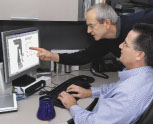Working Model 2D
2D Dynamic Motion Simulation

Simulation Opens the Door to Faster Auto Design
Dearborn, MI - When Timothy W. Taylor, product development engineer at Ford Motor Co., set out to design a new power lift-gate system for a sport utility vehicle, he turned to a recent addition to Ford's design-tool arsenal: Working Model simulation software from Design Simulation Technologies.
An automatic door on a sport utility vehicle typically speeds up slightly as it opens, travels at a constant speed, then slows as it approaches the fully open position - all in a matter of seconds. Taylor knew he wanted this sport utility's door to open at that rate.
Most often at Ford, engineers create geometry in a 2-D drafting package on workstations. They then translate this information and import it into Working Model. But because the geometry of the lift-gate system was simple, Taylor started by creating it within Working Model.
He then constrained the strut model using the software's Constant Velocity Motor. During the simulation, he monitored two specific quantities of the strut: the extensional speed and the force. Both were obtained as a function of the extension, or length change, of the strut through the simulation. Taylor then used these quantities to establish the requirements for the strut.
"The forces in the struts are dependent on the time you select to open the door," says Taylor. "So once you are sure how fast you want the door to open, it's only a matter of running the simulation once."
Using Working Model, he finished the entire study in days. Figuring out the forces necessary by hand would have taken months, he says. Someone would first make rough hand calculations, which alone could take days. Building a prototype could then take several months. And once testing begins, the prototype would most likely need to be "tweaked" to achieve the responses desired.
"That's a terribly time consuming process, and it is very expensive," notes Taylor. "And, the prototypes may not even be able to achieve what you're trying to do because you gave too rough an estimate from your hand calculations.
"With Working Model, setting up very specific design parameters for the struts saves tremendous time and money," he says. "We'll still build a prototype to investigate, but we suspect the first prototype will be very close to what we want so we won't have to build extras."
The bottom line, says Taylor: The company can now bring products to market faster, and that means cheaper products for consumers in the long run. "Because the testing and building is now done analytically, we just verify the design with a prototype," he explains. "Plus, by doing this up-front engineering work, we think we'll end up with a product that's closer to what we want, so customers will be more satisfied."

 Quote
Quote Evaluation
Evaluation



